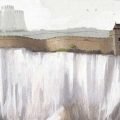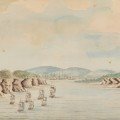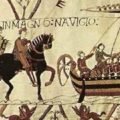 …Cook was now free to go off and fulfill the second part of his assignment—to explore the lands of the South Seas and bring home anything that looked scientifically interesting. To this end, he had with him a brilliant and wealthy young botanist named Joseph Banks. To say that Banks was a dedicated collector is to indulge in the drollest understatement. In the course of the Endeavour’s three-year voyage, he gathered up some thirty thousand specimens, including at least fourteen hundred plants never seen before—at a stroke increasing the world’s stock of known plants by about a quarter. Banks brought so many items back that the Natural History Museum in London has whole drawers full of objects that, 220 years later, await cataloging. The same voyage also made the first successful circumnavigation of New Zealand, confirming that it was not part of the fabled southern continent, as Tasman had optimistically concluded, but two islands. By any measure, it had been a good voyage and we can assume an air of satisfaction as the Endeavour turned at last for home.
…Cook was now free to go off and fulfill the second part of his assignment—to explore the lands of the South Seas and bring home anything that looked scientifically interesting. To this end, he had with him a brilliant and wealthy young botanist named Joseph Banks. To say that Banks was a dedicated collector is to indulge in the drollest understatement. In the course of the Endeavour’s three-year voyage, he gathered up some thirty thousand specimens, including at least fourteen hundred plants never seen before—at a stroke increasing the world’s stock of known plants by about a quarter. Banks brought so many items back that the Natural History Museum in London has whole drawers full of objects that, 220 years later, await cataloging. The same voyage also made the first successful circumnavigation of New Zealand, confirming that it was not part of the fabled southern continent, as Tasman had optimistically concluded, but two islands. By any measure, it had been a good voyage and we can assume an air of satisfaction as the Endeavour turned at last for home.
So when, on April 19, 1770, three weeks out from New Zealand, Lieutenant Zachary Hicks cried “Land ahoy!” at the sight of what turned out to be the extreme southeast tip of Australia, the Endeavour and its crew were already on something of a roll. Cook named the spot Point Hicks (it’s now called Cape Everard) and turned the ship north.
The land they found was not only larger than had been supposed but more promising. For the whole of its length, the east coast was lusher, better watered, and more congenially provisioned with harbors and anchorages than anything that had been reported elsewhere in New Holland. It presented, Cook recorded, a “very agreeable and promising aspect…with hills, ridges, plains and valleys, with some grass but for the most part…covered with wood.” This was nothing like the barren and savage wastes that others had met.
For four months they headed up the coast. They stopped at a place Cook named Botany Bay, ran disastrously aground on the Great Barrier Reef, and finally, after making some urgent repairs, rounded the northernmost tip of the continent at Cape York. On the evening of August 21, almost as an afterthought, he stepped ashore at a place he called Possession Island, planted a flag, and claimed the east coast for Great Britain.
It was a remarkable achievement for a man who had been born a laborer’s son in inland Yorkshire, hadn’t been to sea until he was eighteen, and had only joined the navy thirteen years before at the advanced age of twenty-seven. He would return twice more to the Pacific on even greater voyages—on the next he would sail seventy thousand miles—before being murdered (and possibly eaten himself) by natives on a beach in Hawaii in 1779. Cook was a brilliant navigator and a conscientious observer, but he made one critical mistake on his first voyage: he took Australia’s wet season for its dry one and concluded that the country was more hospitable than it was.
The significance of this misapprehension became evident when Britain lost its American colonies, and, deciding it needed a new place to send its less desirable subjects, plumped for Australia. Remarkably the decision was taken without any attempt at reconnoitering. When Captain Arthur Phillip at the head of a squadron of eleven ships—known reverentially ever after as the First Fleet—set sail from Portsmouth in May 1787, he and the fifteen-hundred-odd people in his care were heading off to start a colony in a preposterously remote, virtually unknown place that had been visited just once, briefly, seventeen years before and had not seen a European face since.
Never before had so many people been moved such a great distance at such expense—and all to be incarcerated. By modern standards (by any standards really), their punishments were ludicrously disproportionate. Most were small-time thieves. Britain wasn’t trying to rid itself of dangerous criminals so much as thin out an underclass. The bulk were being sent to the ends of the earth for stealing trifles. One famously luckless soul had been caught taking twelve cucumber plants. Another had unwisely pocketed a book called A Summary Account of the Flourishing State of the Island of Tobago. Most of the crimes smacked either of desperation or of temptation unsuccessfully resisted.
Generally the term of “transportation” was seven years, but since there was no provision for their return and few could hope to raise the fare, passage to Australia was effectively a life sentence. But then this was an unforgiving age. By the late eighteenth century Britain’s statute books were weighty with capital offenses; you could be hanged for any of two hundred acts, including, notably, “impersonating an Egyptian.” In such circumstances, transportation was quite a merciful alternative.
The voyage from Portsmouth took 252 days—eight months—and covered fifteen thousand miles of open sea (more than would seem strictly necessary, but they crossed the Atlantic in both directions to catch favorable winds). When they arrived at Botany Bay, they found it wasn’t quite the kindly refuge they had been led to expect. Its exposed position made it a dangerous anchorage, and a foray ashore found nothing but sand flies and marsh. “Of the natural meadows which Mr. Cook mentions near Botany Bay, we can give no account,” wrote a puzzled member of the party. Cook’s descriptions had made it sound almost like an English country estate—a place where one might play a little croquet and enjoy a picnic on the lawn. Clearly he had seen it in a different season.
As they stood surveying their unhappy situation, there happened one of those coincidences in which Australian history abounds. On the eastern horizon two ships appeared and joined them in the bay. They were in the command of an amiable Frenchman, Count Jean-François de La Pérouse, who was leading a two-year journey of exploration around the Pacific. Had La Pérouse been just a little faster, he could have claimed Australia for France and saved the country two hundred years of English cooking. Instead, he accepted his unlucky timing with the grace that marked the age. La Pérouse’s expression when it was explained to him that Phillip and his crew had just sailed fifteen thousand miles to make a prison for people who had stolen lace and ribbons, some cucumber plants, and a book on Tobago must have been one of the great looks in history, but alas there is no record of it. In any case, after an uneventful rest at Botany Bay, he departed, never to be seen again. Soon afterward his two ships and all aboard were lost in a storm off the New Hebrides.
Meanwhile, Phillip, seeking a more amenable location, sailed up the coast to another inlet, which Cook had noted but not explored, and ventured through the sandstone heads that form its mouth. There he discovered one of the great harbors of the world. At the point where Circular Quay now stands, he anchored his ships and started a city. It was January 26, 1788. The date would live forever as Australia Day.
Among the many small and interesting mysteries of Australia in its early days is where so many of its names come from. It was Cook who called the eastern coast New South Wales, and no one now has any idea why. Did he mean to signify that this would be a new Wales of the South or merely a new version of South Wales? If the latter, why just South Wales and not the whole of it? No one now can say. What is certain is that he had no known connection to that verdant principality, southerly or otherwise.







